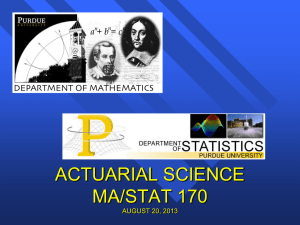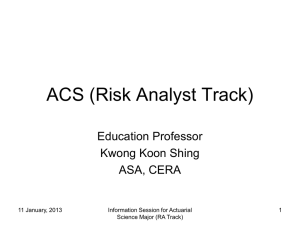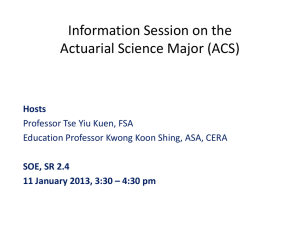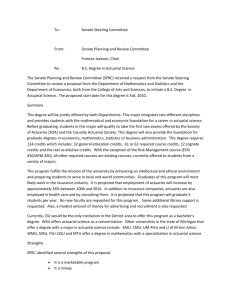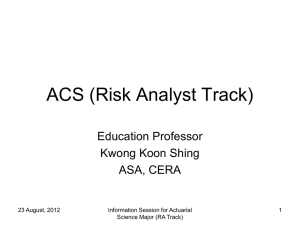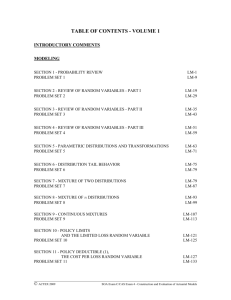actuarial credentials - Carolina`s Actuarial Student Organization
advertisement
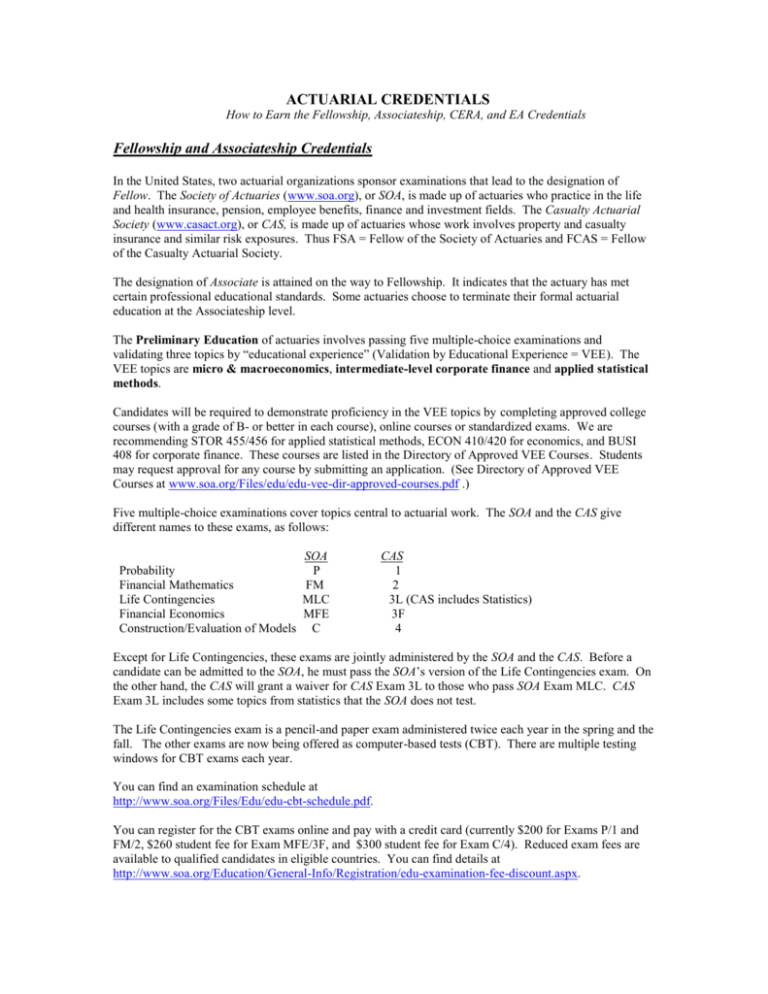
ACTUARIAL CREDENTIALS How to Earn the Fellowship, Associateship, CERA, and EA Credentials Fellowship and Associateship Credentials In the United States, two actuarial organizations sponsor examinations that lead to the designation of Fellow. The Society of Actuaries (www.soa.org), or SOA, is made up of actuaries who practice in the life and health insurance, pension, employee benefits, finance and investment fields. The Casualty Actuarial Society (www.casact.org), or CAS, is made up of actuaries whose work involves property and casualty insurance and similar risk exposures. Thus FSA = Fellow of the Society of Actuaries and FCAS = Fellow of the Casualty Actuarial Society. The designation of Associate is attained on the way to Fellowship. It indicates that the actuary has met certain professional educational standards. Some actuaries choose to terminate their formal actuarial education at the Associateship level. The Preliminary Education of actuaries involves passing five multiple-choice examinations and validating three topics by “educational experience” (Validation by Educational Experience = VEE). The VEE topics are micro & macroeconomics, intermediate-level corporate finance and applied statistical methods. Candidates will be required to demonstrate proficiency in the VEE topics by completing approved college courses (with a grade of B- or better in each course), online courses or standardized exams. We are recommending STOR 455/456 for applied statistical methods, ECON 410/420 for economics, and BUSI 408 for corporate finance. These courses are listed in the Directory of Approved VEE Courses. Students may request approval for any course by submitting an application. (See Directory of Approved VEE Courses at www.soa.org/Files/edu/edu-vee-dir-approved-courses.pdf .) Five multiple-choice examinations cover topics central to actuarial work. The SOA and the CAS give different names to these exams, as follows: SOA Probability P Financial Mathematics FM Life Contingencies MLC Financial Economics MFE Construction/Evaluation of Models C CAS 1 2 3L (CAS includes Statistics) 3F 4 Except for Life Contingencies, these exams are jointly administered by the SOA and the CAS. Before a candidate can be admitted to the SOA, he must pass the SOA’s version of the Life Contingencies exam. On the other hand, the CAS will grant a waiver for CAS Exam 3L to those who pass SOA Exam MLC. CAS Exam 3L includes some topics from statistics that the SOA does not test. The Life Contingencies exam is a pencil-and paper exam administered twice each year in the spring and the fall. The other exams are now being offered as computer-based tests (CBT). There are multiple testing windows for CBT exams each year. You can find an examination schedule at http://www.soa.org/Files/Edu/edu-cbt-schedule.pdf. You can register for the CBT exams online and pay with a credit card (currently $200 for Exams P/1 and FM/2, $260 student fee for Exam MFE/3F, and $300 student fee for Exam C/4). Reduced exam fees are available to qualified candidates in eligible countries. You can find details at http://www.soa.org/Education/General-Info/Registration/edu-examination-fee-discount.aspx. Diversity students – African North American, Hispanic, or Native North American – who pass the Probability exam and/or the Financial Mathematics exam will be reimbursed for the fees for the passed exams; more info is available at www.beanactuary.org/programs/diversity/?fa=diversity-examreimbursement-program. Undergraduate MDS majors who pass Exam P but do not qualify as a Diversity student will be reimbursed $100 by the UNC Statistics and Operations Research Department. The best course preparation for the Probability exam (P/1) is STOR 435. UNC does not offer a course that will prepare you for the Financial Mathematics exam (FM/2), but the compound interest topic that we study in STOR 471 will give you a jump-start on the interest theory. BUSI 588 (Derivative Securities and Risk Management) should help you prepare for the financial economics on Exam FM/2 and, to a lesser extent, for some of the learning outcomes on Exam MFE/3F. Most of the material in STOR 471/472 is taken from the exams on Life Contingencies and Construction/Evaluation of Models. The Probability exam is difficult, and passing it requires a fair amount of study and preparation. How do you prepare for the Probability exam? Here are a few suggestions. (1) Sample problems taken from past exams are available online. You can find links to sample exam questions and solutions at http://www.beanactuary.org/exams/preliminary/?fa=probability-exam. (2) The Actuarial Bookstore (www.actuarialbookstore.com) offers study manuals, seminars and online courses. (3) Actuarial discussion forums for the Probability exam can be accessed at www.actuary.com and www.actuarialoutpost.com. (4) Organize your own study group. We have a student actuarial club at UNC known as CASO (Carolina Actuarial Student Organization). One of CASO’s missions is to help students who are studying for the same exam to contact one another. CASO is on the web at www.caso.web.unc.edu. (5) Join an e-mail study group by completing an online form at the Casualty Actuarial Society’s web site (http://www.casact.org/admissions/index.cfm?fa=email). Changes in Preliminary Education are scheduled for 2014. The Joint Preliminary Actuarial Examination Agreement between the SOA and the CAS will terminate on December 31, 2013. Casualty Exam 3L will be separated into two new exams—Exam LC (survival models and life contingencies) and Exam ST (statistics and stochastic processes), which will be produced and administered independently by the CAS. For learning objectives currently addressed through Exams 1, 2, 3F, and 4, the CAS will grant credit to candidates who receive credit for examinations offered by the SOA and other organizations. Effective with the Spring 2014 administration, SOA Exam MLC will change from being a strictly multiple-choice exam to one with both multiple-choice and written-answer components. You can find the requirements for Associateship in the CAS at www.casact.org/admissions/syllabus/ and for Associateship in the SOA at http://www.soa.org/Education/Exam-Req/edu-asa-req.aspx. If you are pursuing the SOA career path, you will start the Fundamentals of Actuarial Practice course after you finish the Preliminary Education requirements. FAP is an e-Learning course that targets individuals who want to become Associates of the Society of Actuaries. It includes both online and offline activities and exposes you to real-world situations. FAP is made up of eight Internet-based modules, and it includes two comprehensive exercises that are formally graded. One module a month is a reasonable pace. After achieving Associateship status and usually after gaining a few years of work experience, you can complete the Fellowship course by passing more examinations and completing more e–Learning modules. Fellowship candidates choose one of these six specialty tracks: Corporate Finance & Enterprise Risk Management, Quantitative Finance & Investment, Individual Life & Annuities, Retirement Benefits, Group & Health, General Insurance. Most candidates pursuing a Fellowship (FSA) with the SOA have the option to receive a CERA credential (see description below) on their path to FSA with just 2 additional exam hours. The Casualty Actuarial Society has developed two self-paced internet-based courses for candidates pursuing Associateship. The CAS will use these courses to assess material that requires knowledge at a familiarity level only. Each course will prepare you for a multiple-choice exam with an expectation of a high success rate. In addition, candidates for Associateship must pass two traditional exams (Exams 5 & 6) that will assess material that requires knowledge at a master level. After achieving Associateship status, you can complete the Fellowship course by passing three more traditional exams numbered 7, 8 and 9. Unlike other professions, such as law and medicine, in the actuarial profession you can earn while you learn. Many students receive on-the-job training while enrolled in the examination process. Employers are generally supportive and may give students study time during working hours, pay exam fees, and award raises for each exam passed. Many insurance companies and consulting firms have summer or part-time jobs for actuarial students. Besides offering on-the-job experience, these positions are a good way to see whether you're suited to an actuarial career. CERA - The Enterprise Risk Management (ERM) Credential The CERA Enterprise Risk Management credential is the most comprehensive and rigorous globallyrecognized Enterprise Risk Management (ERM) designation and is supported by 13 member associations in 12 countries worldwide, including many of the major economies. CERAs are uniquely qualified to address all types of risk, including financial, operational and strategic risks, by virtue of their training in qualitative and quantitative aspects of enterprise risk management and their experience in integrating diverse insights into business solutions. The CERA designation is awarded through qualified participating associations, and it recognizes actuaries globally who meet stringent education requirements in enterprise risk management (ERM) and who are governed by a strong code of professional conduct. Both the SOA and the CAS offer CERA. You can find the SOA requirements to qualify for the CERA designation at http://www.soa.org/Education/Exam-Req/edu-cera-req.aspx. Candidates who have the Application for Admission as an Associate approved by the SOA Board of Directors will be granted membership as an ASA. The CAS requirements to qualify for the CERA designation include CAS Associateship requirements plus credit for CAS Exams 7 and 9, or attainment of the CAS Fellowship designation, plus participation in a rigorous three-day seminar and successful completion of the U.K. ST-9 Enterprise Risk Management Specialist Technical Exam (ST-9 exam). The Enrolled Actuary Credential An Enrolled Actuary (EA) is an actuary who has been licensed by a Joint Board of the Department of Treasury & Department of Labor in the U.S. to perform a variety of actuarial tasks that are required for pension plans in the U.S. The SOA administers multiple–choice examinations on behalf of the Joint Board for the Enrollment of Actuaries. Information on the Enrolled Actuaries Examinations is available on the Society of Actuaries web site at http://www.soa.org/education/exam-req/edu-exam-ea-detail.aspx.

